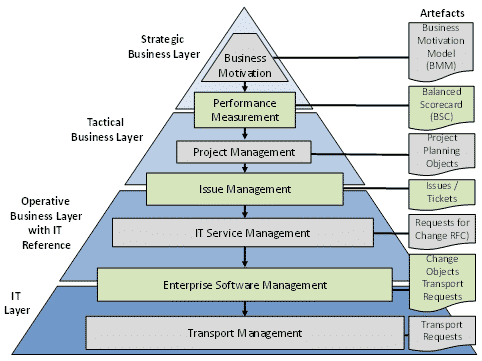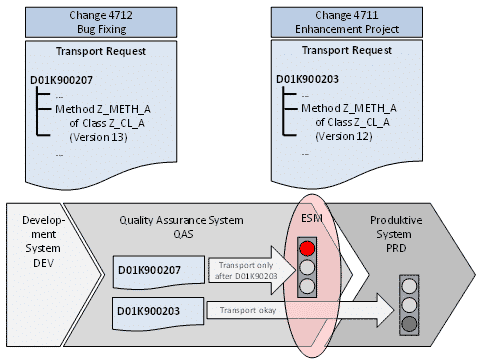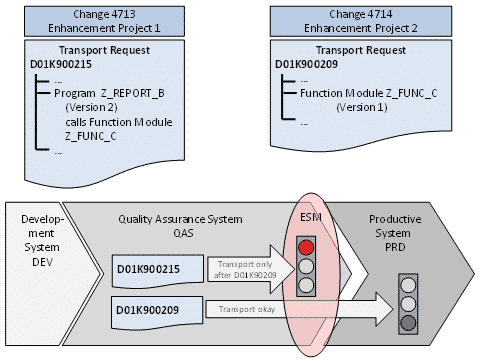However, the two worlds should not be considered separately to avoid isolated applications. Instead, companies need a holistic IT concept depicting IT tools for both strategic change and operations.
In corporate practice, there is often a gap between the top-level corporate strategy, the project management for the strategy implementation, the breaking down to ITIL-appropriate change processes – as far as software adjustments are required in a project, and the relatedness of a change process to individual detailed code changes at one point in the system landscape. Here the vertical integration is missing. Without transparency, however, it is difficult to compare the project success and costs of digitalisation projects and to prove the successful implementation of the strategy.
Further challenges arise from the areas of Compliance and Governance, which expect a gapless documentation of the software adjustments related to the underlying requests for change. In particular, SAP system landscapes imply a special level of complexity in software adjustments that have to be checked for inconsistencies in various ways before they can be installed in the productive environment. Key words are 4-system landscapes, ‘Override’ and ‘Overtake’ as well as critical and dependent objects.
Enterprise Software Management (ESM) closes this gap in two ways. On the one hand, ESM tools are integrated into project management applications and Ticketing Systems and thus create a reach-trough from corporate strategy over planned projects to ITIL-Changes. On the other hand, they manage the transfer orders collected in the Change Processes, conduct tests, warn in cases of incompatibilities in the target system and document the course of each change for internal and external audits. This performance of integration enables the efficient operation of the Systems of Records, while providing the freedom to plan and implement digitalisation projects, whose software adjustments can be controlled in the same way as the maintenance tasks. In this way, ESM tools also contribute to the integration of the Systems of Engagement into the IT landscape.
Digital Transformation and Challenges for Enterprise IT
The term Digital Transformation summarises a wide range of aspects of a more and more digitalised world, in which established companies need to work on a fundamental reorientation of their products, services, processes and business models in order to survive in an increasingly dynamic market environment [1]. In the age of digital transformation companies face many challenges [2]:
- Agility: Due to the drastic pace of change in market and competition conditions, an adaptive IT is a critical success factor. A long-lasting optimal IT system landscape is replaced by prototypes for digitalisation projects, which, in case of success, are complemented, developed and scaled flexibly by the project team.
- Ability to innovate: In the age of digital transformation, corporate priority is shifting from incremental improvements of the existing offerings to radically new ideas and a start-up-like behaviour. IT must adapt to this change, e.g. with iterative approaches to the process models for software development such as Scrum and DevOps to accelerate the development, deployment and further development of applications and services.
- Simplicity: Not only customers expect intuitive user interfaces and a consistent customer experience. Even the back office that has to keep the legacy systems in service, which are complex and difficult to maintain due to adjustments, extensions and networking, requires IT support for simple and convenient process control and communication. The efficient operation of the legacy systems provides the time needed for digitalisation experiments.
- Intelligent use of data: Data collection, storage and real-time evaluation with intelligent evaluation algorithms bring added value to companies and form the basis for process optimisation, improved decision-making and business innovation.
The approach of operating a two-tier system landscape is just an interim solution. Only by integrating the system worlds, companies can avoid isolated solutions and, in case of success, transfer matured prototypes gradually to the product and service portfolio as well as to the well-known maintenance and development processes.
ESM for efficiency measurement of digitalisation projects and change processes
In any digitalisation approach, companies must ask themselves if the project meets the expectations, whether it implements the corporate strategy appropriately and if the benefits outweigh the costs. To answer these questions, the companies must transparently document and integrate all levels of management. Usually, the decision for digitalisation begins with the executive management, which clarifies the self-conception and the basic principles in the mission statement. An electronic form of vision and mission, such as the Business Motivation Model (BMM), helps to communicate the direction of the strategy within the company, highlighting the differences between the goals and purposes, on the one hand, and the means and ways to implement them, on the other hand.
An example of a tool for BMM modelling is a prototype that was created at the Mannheim University of Applied Sciences at the Faculty of Computer Science as part of a student project. It has already been tested in practice [3]. The transition to the tactical level of strategy implementation is provided by Performance Measurement Systems, e.g. Balanced Scorecards (BSC), which adopt the objectives and define measures for achieving the objectives, for example in project form. The projects in the BSC can refer to project structure plans, networks and work packages in Project Management Systems, where project managers plan, organise and control the projects. While some work packages are processed without reference to IT systems, some other require changes in the IT world. For example, for these adjustments, the project team members open tickets in Issue Management Systems. This, in turn, is closely related to IT Service Management, which controls change processes often based on ITIL via Request for Change (RFC).
The integration ends, at the latest, on this operational business level with IT relation. At the technical IT level, Transport Management follows in SAP environments, but a link to the business levels is missing. The Enterprise Software Management (ESM) (cf. figure 1) closes this gap and thus contributes to the Business-IT-Alignment. The ESM undertakes the RFCs of the IT Service Management and manages the change processes in detail with the assigned transfer orders. This makes it possible to comprehend which RFC was the cause for which code change in which system at any time, and which Transport Requests have supplied the productive system. Integrating all levels, the executive management can see, virtually at the touch of a button, which strategic objective should be reached via which projects, which IT adjustments were necessary and who made the change by which Transport Requests [4].

Thinking further of cost-benefit considerations for a digitalisation strategy, ESM can form the basis for the cost-effective assessment of the software adjustments. For this purpose, all objectives linked to the vision and mission of the strategy have to be collected in the BSC and the stored projects evaluated. All IT-related project work packages lead on to linked RFCs or tickets, and ultimately to change processes. Integration with the ESM finally makes it possible to comprehend which code changes were made in the system landscape. The change effort, for example based on the effort estimation in person days, can be contrasted with an evaluation of the range of functions of the extensions, for example according to the Functional Size Measurement in the context of a Function-Point-Analysis.
ESM makes transport risks in complex system landscapes manageable
A closer look at the IT sector reveals that even small-code code changes can be enormously complex and pose a risk to the productive environment. The 3-system landscape with software adjustments in the development system, the transport to the quality assurance system and tests there, as well as, in case of success, the release and import into the productive system is only the simplest scenario. With varying degrees of urgency of software changes, such as longer-term development, migration or upgrade projects on the one hand, and necessary short-term error corrections on the other hand, many companies expand the 3-system landscape to a 4- or even 5-system landscape. There, a second development system, and possibly another test system, will bring the maintenance results into the productive system promptly. The planning, documentation and maintenance of system landscape components in an application lifecycle management system such as SAP Solution Manager should ensure transparency to the landscape infrastructure, but these tools do not cover the analysing and reviewing of code changes in individual transport jobs, and interoperating with other jobs.

Hereto, companies also need Enterprise Software Management (ESM). ESM monitors the entire process chain of object changes, triggered by a Change, in all affected systems in the system landscape, and controls these centrally. A Change process may generate a large number of transport jobs at the IT level that need to reach the productive system in the correct order. The ESM keeps track of the impact of all code adjustments that are associated with a change process, and monitors the interactions between the Transport Requests of all IT-relevant Changes.
A potential risk is, for example, the so called ‘Override’ where the Transport Management System first supplies the productive system with the current version of an object. Later, it is overwritten by the import of an older version of the code of the object. An example of this is shown in figure 2. In this example, two Transport Requests contain the same object, a method of class Z_CL_A, which, on the one hand, was changed as part of an extension project and for which, on the other hand, an urgent error correction had to be performed. For organisational and/or technical reasons, the testers were able to complete the troubleshooting check faster than the test of the extension project. Nevertheless, version 13 of the method must not be brought into the productive system after version 12 has been installed, otherwise the older version 12 would overwrite the newer version 13 in the productive system. In this case, the bug that is believed to be fixed would be present again in the productive environment.
The so called ‘Overtake’ is a further danger. Objects contain parts of developments whose counterparts reach the target system only in later imported transports, so that in the productive system the adjustment is incomplete and the application may react incorrectly. For example, running a program requires another object, maybe because the program is calling a function module or a method. If the adjustments of the object and its callers reach the productive system asynchronously, the application may not work as expected.
If the interface changes in a non-upward-compatible way, for example because a mandatory transfer parameter is required, all calling programs must make the change. A time offset when importing the Transport Requests, in which the object and caller are located, causes a dump. The same happens when an object has been recreated and its callers have already reached the productive environment while it is still on its way.
Again, the program dumps at the execution attempt. Figure 3 shows a concrete overtake scenario where the report Z_REPORT_B contains a call of the function module Z_FUNC_C in the code, but does not transport the module itself since it was created by another project team and brought into the quality assurance system in another extension project. Uncovering ‘Overtakes’ is much more difficult than listing possible ‘Override’ risks because the overtaken objects are not visible on the Transport Request. Only an extensive code analysis helps here.

With hundreds of Transport Requests and thousands of objects in them, these dependencies and checks are no longer manageable manually due to bug fixes, in-house developments, extensions or upgrades, and must be monitored by an ESM tool. It is crucial that the ESM tool acts widely automatically and monitors all transports by default in order to increase the stability of the target system, whether it is the quality assurance system, which benefits from improved test basics, or the productive system, where the impact of faulty imports is far more sensible. Ideally, the ESM creates a list of critical transports and issues warnings about their latent dangers. The Enterprise Software Management by Solutive AG is an example for an ESM solution with extensive check routines.
ESM for Governance, Risk and Compliance (GRC)
Ultimately, beyond measuring the success of digitalisation risks and managing IT operations, an ESM tool is helpful for stakeholders with Governance, Risk and Compliance (GRC) requirements. Internal business rules can also be applied to the technical implementation of software adjustments and require the transparent adherence to the dual control principle for code changes, the personnel separation of responsibilities for development and testing, as well as the limitation of authorisations to the degree appropriate for the user role.
To prove that the processes at the IT level are in accordance with the rules, there is traceable evidence for audits and revisions in the ESM. The ESM is also relevant to external auditing. Auditors are increasingly asking for insight into the change process and the responsibilities that apply. If a company uses an ESM tool, it can create clear reports on the adjustments in the productive environment at the touch of a button and provide them at short notice on demand.
Documentation and evaluation of the code changes relevant to the audit are standard in several ESM tools, including the Enterprise Software Management solution of Solutive AG. The integration of the business and IT levels in the sense of Business-IT-Alignment outlined above is still a challenge. Therefore, for the proof of concept, a student project at the Mannheim University of Applied Sciences in the coming summer semester 2018 shall carry out a cost-benefit analysis of digitalisation projects by integrating all levels of corporate management with the IT level via Enterprise Software Management. It is planned to use the Enterprise Software Management of Solutive AG as an ESM solution,which already has the necessary interfaces for integration into Project Management Systems, Ticketing Systems and IT Service Management solutions.
References
- Kreutzer, R.T., Neugebauer, T., Pattloch, A. (2017). Digital Business Leadership. Wiesbaden.
- Châlons, C., & Dufft, N. (2016). Die Rolle der IT als Enabler für Digitalisierung. In F. Abolhassan (Ed.), Was treibt die Digitalisierung? Wiesbaden.
- Gröschel, M., & Roth-Dietrich, G. (2016). Modeling the Business Model and Business Strategy – Conception and Implementation of OMG’s Business Motivation Model in Software Prototype. In D. Hertweck, & C. Decker (Eds.), Digital Enterprise Computing, Lecture Notes in Informatics (LNI). Bonn.
- Roth-Dietrich, G. (2017). Innovative Digitalisierungsstrategien durch Business-IT-Alignment. ERP-Management, 13, 4, 32-34.






















Very insightful and informative piece on the why and what of Enterprise Software Management.. Good Read!